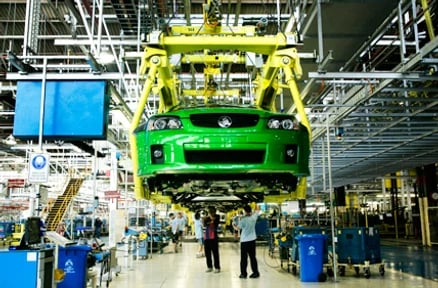June 14, 2013
Challenges for the Australian automotive industry.
Nov 12, 2012
The Australian automotive industry’s main challenges fall into 3 domains:
- Impact of the macro economic environment
- Very high levels of competition in the relatively small Australian market
- Changing consumer needs and values effecting all aspects of marketing
1. Macro environment:
Historically macro considerations have been confined simply to the context in which the industry operates. But today the ability to change business models more quickly, and the opportunities for prospect profiling, knowledge and personalization mean they can become a significant opportunity for today’s smart automotive marketer.
The car industry has increasingly become one commanding a global strategic play, with significant conglomerates capitalizing on global economies of scale. Efficiently maximising production capacity means volume goals are key to profitability.
Some niche brands aside (like Tesla) this has largely created barriers to competitive entry. The disadvantage for a small total volume market (below 1m units per year) like Australia is that they will have little influence on what vehicles are ultimately made globally.
Difference in the health of geographical economies has a huge impact – with currently China and the US compensating for volume declines in much of Europe. Inevitably this can lead to changes in business strategy for a market like Australia, where margin rather than cost recovery is normally a more appealing proposition. The success in these markets comes from cherry-picking the available vehicles and marketing them in an appropriate way for the local market’s needs.
But even here, the health of the local economy has a significant bearing on how long many consumers will try and stretch the life of their vehicle.
Political decisions, population trends, fuel prices, finance affordability, motor vehicle density, and urban development can each play a significant part in local car manufacturer strategies.
The implication is that car partners need to fully understand and adapt to the business model, whilst smartly leveraging pertinent data.
2. Competition:
Australia is the most competitive car market in the world. The Australian Auto market has a staggering 64 separate brands (relative to 32 in the USA) and no less than 240 name plates.
The traditionally ubiquitous mainstream brands like Holden, Nissan, Mitsubishi, and Ford are ‘pushing down’ on the lower end vehicles by democratizing the tech features of the upper end of the market. At the same time their brand power is eroding.
At the ‘lower’ end the so-called ‘Value’ brands like Hyundai are pushing upwards as reliability becomes a more universal value, and subjective criteria like style improve. This has led to marked differences in brand appeal amongst consumer segments.
The distinctive prestige car marques no longer carry the same degree of reverence they once enjoyed. Partially this is a category shift, and partially the result of brands like Audi blurring the divide. The extent of price bands for brands is greater than ever: e.g. less than $40k can now buy a new Mercedes, BMW, Lexus or Audi.
Today’s perceptual map of the Australian car market is defined by the dimensions of premium-ness and innovation. Modeling overseas brands like Tesla shows reveals that there is real potential to disrupt this.

The implication is that brands need to have a story and script that really helps them stand out.
3. Consumer and Category shifts:
‘Cars aren’t what they used to be’. Technically they are dramatically better. But in terms of meaning their value has lessened. The aura, which even the elite marques conveyed has fallen dramatically over the last 20 years in Australia.
There has been a clear overall shift from prestige towards pragmatism. Indeed, new cars are more accessible to more people today: 50 years ago a typical Holden family car cost 45 weeks of average worker earnings. Today the equivalent is just 28 weeks. (commsec).
It is yet to be seen how far pragmatic attitudes will translate into behaviors, but there is a rising tide to the point of attitudinal rejection of the car, particularly amongst some inner city millennials. Ultimately this may simply result in delayed purchase. However, it is evidence that differences between generations have joined differences in gender in attitudes towards cars, adding new layers of complexity.
Inner city millennials are interesting. We’ve done a lot a qual research with this group this year. A theme we are seeing is that buying a home is now considered so far out of reality that they no longer aspire to it. The car (together with and as a part of tech) is increasingly an aspiration/way to demonstrate their personal successes. I think we’ll start seeing specific strategies to engage this group – like a Coca-Cola social media strategy for auto.
Consumers are expressing more individual needs, reflected in the breadth of desire from large SUV’s and demand for a mini choice.
They are displaying a growing thirst to embrace innovation in vehicles, and this has become an important new currency for manufacturers to leverage.
These can be aligned to a diverse set of consumer motivations which reflect perspectives as diverse as seeking a mobile cocoon, a mere product of mobility, or a more defining statement of ideal self.
As product differentiation becomes increasingly difficult, the emotional value of brand differentiation still assumes a valuable role. But they need to tell a story that encompasses the full experience of brand, product and service. And ensure they can command cultural relevance.
A slightly different perspective on this that we talk about is the separation of commoditized and premium car brands. If you look just at the brands in growth (that is brands with a +5% YOY growth in units sold) in Australia you could put them into one of two categories – commodity brands and premium brands:
Commodity brands are typically low budget small vehicles.Hyundai, Kia are the obvious ones here, but check out some of the Chinese brands like Cherry.they sell no frills, get you from A-B vehicles and they are so inexpensive to be almost ‘disposable’ at the end of their warranty periods (usually 5 years in place of a standard 3).
Premium brands are typically +$40k European vehicles – think big 3, BMW, Mercedes, Audi and the specialist brands (they sell more Lamborghinis per-capita in Australia than anywhere else in the world… even Monaco.Also, VW have massive growth in the +$40k range.
I believe this shows a trend in the Oz market as a reflection of point 1.We’ve got enough money to allow us to buy vehicles now purely as a functional item (where key features are the selling point) or purely as a reflection of who we are (where brand attributes are the selling point).Whereas before cars needed to do both to some extent.
Why is this such a big deal?The challenge of this trend will hit the established volume players – critically Toyota, Ford, GM/Holden and Mazda – do they want to be a commoditized or a premium car brand?Toyota appear to be the best organised to respond and are starting to really leverage their Lexus brand.Both Ford and GMH are focused on the commoditized side – certainly with Ford our biggest ‘one to watch’ is Hyundai now.Mazda I think are making a play in to the lower end of the premium bracket (want to be seen against VW)… however, their product really isn’t comparable yet.The new 3 still isn’t a Golf.
One final thought, the Australian consumer really doesn’t care about sustainability – we’d all say that we do if asked, but the reality is that small and fuel efficient engines or hybrids of any kind don’t sell cars here – power does.
NOTE: This article was the result of a piece of analysis done in partnership with legendary strategist Keith Newton, BAV.



